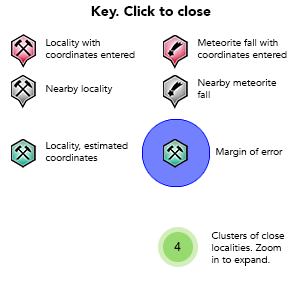Quality Aggregates - University Park Mine, Manatee Co., Florida, USA

| Latitude & Longitude (WGS84): | 27° 24' 10'' North , 82° 26' 49'' West |
|---|---|
| Latitude & Longitude (decimal): | 27.40278,-82.44694 |
| GeoHash: | G#: dhv7gueby |
| Locality type: | Mine |
| Köppen climate type: | Cfa : Humid subtropical climate |
Spencer, S.M., 1993, Industrial Minerals Industry Directory Of Florida, Florida Geological Survey, Information Circular Ic-109, 30 Pp.
Commodities (Major) - Limestone - General
Development Status: Producer
Structure: Limestone
Commodity List
This is a list of exploitable or exploited mineral commodities recorded at this locality.No minerals currently recorded for this locality.
Regional Geology
This geological map and associated information on rock units at or nearby to the coordinates given for this locality is based on relatively small scale geological maps provided by various national Geological Surveys. This does not necessarily represent the complete geology at this locality but it gives a background for the region in which it is found.
Click on geological units on the map for more information. Click here to view full-screen map on Macrostrat.org
| Cenozoic 0 - 66 Ma ID: 3186031 | Cenozoic sedimentary rocks Age: Cenozoic (0 - 66 Ma) Lithology: Sedimentary rocks Reference: Chorlton, L.B. Generalized geology of the world: bedrock domains and major faults in GIS format: a small-scale world geology map with an extended geological attribute database. doi: 10.4095/223767. Geological Survey of Canada, Open File 5529. [154] |
| Pleistocene - Late Pliocene 0.0117 - 3.6 Ma ID: 2758299 | Shelly sediments of Plio-Pleistocene age Age: Cenozoic (0.0117 - 3.6 Ma) Description: Tertiary-Quaternary Fossiliferous Sediments of Southern Florida - Molluskbearing sediments of southern Florida contain some of the most abundant and diverse fossil faunas in the world. The origin of these accumulations of fossil mollusks is imprecisely known (Allmon, 1992). The shell beds have attracted much attention due to the abundance and preservation of the fossils but the biostratigraphy and lithostratigraphy of the units has not been well defined (Scott, 1992). Scott and Wingard (1995) discussed the problems associated with biostratigraphy and lithostratigraphy of the Plio-Pleistocene in southern Florida. These "formations" are biostratigraphic units. The "formations" previously recognized within the latest Tertiary-Quaternary section of southern Florida include the latest Pliocene - early Pleistocene Caloosahatchee Formation, the early Pleistocene Bermont formation (informal) and the late Pleistocene Fort Thompson Formation. This section consists of fossiliferous sands and carbonates. The identification of these units is problematic unless the significant molluscan species are recognized. Often exposures are not extensive enough to facilitate the collection of representative faunal samples to properly discern the biostratigraphic identification of the formation. In an attempt to alleviate the inherent problems in the biostratigraphic recognition of lithostratigraphic units, Scott (1992) suggested grouping the latest Pliocene through late Pleistocene Caloosahatchee, Bermont and Fort Thompson Formations in to a single lithostratigraphic entity, the Okeechobee formation (informal). In mapping the shelly sands and carbonates, a generalized grouping as Tertiary-Quaternary shell units (TQsu) was utilized. This is equivalent to the informal Okeechobee formation. The distribution of the Caloosahatchee and Fort Thompson Formation are shown on previous geologic maps by Cooke (1945), Vernon and Puri (1964) and Brooks (1982). The Nashua Formation occurs within the Pliocene - Pleistocene in northern Florida. However, it crops out or is near the surface is an area too small to be shown on a map of this scale. Lithologically these sediments are complex, varying from unconsolidated, variably calcareous and fossiliferous quartz sands to well indurated, sandy, fossiliferous limestones (both marine and freshwater). Clayey sands and sandy clays are present. These sediments form part of the surficial aquifer system Lithology: Major:{sand,limestone}, Minor:{clay} Reference: Horton, J.D., C.A. San Juan, and D.B. Stoeser. The State Geologic Map Compilation (SGMC) geodatabase of the conterminous United States. doi: 10.3133/ds1052. U.S. Geological Survey Data Series 1052. [133] |
Data and map coding provided by Macrostrat.org, used under Creative Commons Attribution 4.0 License



